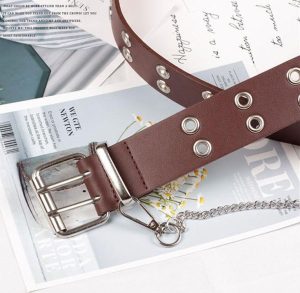Belts are a versatile accessory that can elevate any outfit. But like any other wardrobe essential, they need proper care to maintain their look and longevity. Here’s a comprehensive guide on how to clean a belt, covering different materials and common cleaning scenarios.
Leather Love: Cleaning Your Leather Belt
Leather belts are a classic choice, but they require specific cleaning methods. Here’s how to keep your leather belt looking its best:
-
Gather your supplies: You’ll need a soft, lint-free cloth, a leather cleaner (or mild soap), and a leather conditioner.
-
Brush away dust: Before cleaning, gently brush the belt with a soft-bristled brush to remove any loose dirt or dust.
-
Spot clean stains: Address any stains promptly. Apply a small amount of leather cleaner or a solution of mild soap and water to a damp cloth. Test the solution on an inconspicuous area of the belt first. Gently dab the stain, working from the outside inward. Avoid oversaturating the leather.
-
Clean the entire belt (optional): If your nice belt needs a more thorough cleaning, dampen your cloth with clean water and wipe down the entire surface. Don’t soak the leather!
-
Let it dry naturally: Let the belt air dry completely away from direct sunlight or heat sources. This can take several hours.
-
Condition the leather: Once the belt is dry, apply a leather conditioner to nourish and protect the material. Use a clean cloth and buff it gently into the leather.

Fabric Flair: Cleaning Your Fabric Belt
Fabric belts offer a casual and stylish touch. Here’s how to keep them clean:
-
Check the care label: Always refer to the care label on your fabric belt for specific cleaning instructions. Some fabric belts may be hand-wash only, while others might be machine-washable.
-
Spot cleaning: For minor stains, address them promptly with a damp cloth and a mild detergent solution. Test the solution on an inconspicuous area first. Gently dab the stain and blot with a clean, dry cloth.
-
Handwashing (if applicable): If the care label allows, hand-wash your fabric belt in cold water with a gentle detergent. Avoid harsh scrubbing or wringing. Rinse thoroughly with clean water.
-
Machine washing (if applicable): For machine-washable fabric belts, use a gentle cycle with cold water and a mild detergent. Place the belt in a mesh laundry bag for added protection.
-
Air drying: Regardless of the washing method, air dry your fabric belt completely. Avoid using dryers, which can shrink or damage the fabric.
Beyond Leather and Fabric: Cleaning Other Belt Materials
Belts come in various materials, each requiring slightly different cleaning approaches:
Synthetic belts:
Wipe down synthetic belts with a damp cloth and a mild soap solution. Avoid harsh chemicals or abrasive cleaners.
Straw belts:
Spot clean straw belts with a soft brush and a mild detergent solution. Let them air dry completely.
Beaded belts:
For beaded belts, use a soft, dry brush to remove dust and debris. Avoid using water or cleaning solutions, as they can damage the beads or thread.
Preventing Stains: Keeping Your Belts Looking Fresh
An ounce of prevention is worth a pound of cure! Here are some tips to prevent stains on your belts:
-
Store them properly: Store your belts in a cool, dry place away from direct sunlight. Dust bags can offer additional protection.
-
Treat spills immediately: Address spills on your belt as soon as possible to prevent them from setting in. Blot the spill with a clean, absorbent cloth.
-
Avoid over-exposure to elements: Limit your belt’s exposure to rain, snow, or excessive heat, as these elements can damage the material.
By following these simple cleaning and prevention tips, you can ensure your belts stay looking sharp and last for years to come.

DIY Cleaning Solutions (Optional):
While commercial leather cleaners and conditioners are readily available, you can also create your own natural cleaning solutions at home. However, it’s important to patch test any DIY solution on an inconspicuous area of the belt first to ensure it doesn’t cause discoloration or damage. Here are two popular options:
-
Leather cleaner: Mix equal parts white vinegar and water in a spray bottle. Spray a small amount onto a clean cloth and wipe down the belt. Let it air dry completely before buffing with a soft cloth.
-
Leather conditioner: Mix equal parts olive oil and white vinegar in a bowl. Apply a small amount of the mixture to a clean cloth and buff it gently into the leather. Let it dry completely before buffing again with a clean, dry cloth.

When to Call in the Professionals
For heavily soiled belts, delicate materials, or stubborn stains, it’s best to consult a professional cleaner. They have the expertise and equipment to handle more complex cleaning situations without damaging your belt.
Repurposing Old Belts: Breathe New Life into Your Wardrobe
Maybe your belt is a little too worn for everyday wear, but it holds sentimental value or has interesting hardware. Here are some creative ways to repurpose old belts:
-
Cut it into a bracelet: Belts with interesting buckles or patterns can be cut and transformed into unique bracelets.
-
Use it for crafting: Leather belts can be cut into strips for various craft projects like belts for bags or decorative trim.
-
Swap the buckle: Update the look of an old belt with a new, stylish buckle.
By giving your old belts a second life, you can reduce waste and add unique pieces to your wardrobe.
Sustainable Style: Choosing Eco-Friendly Belts
Looking for ways to incorporate sustainable practices into your wardrobe? Consider these eco-conscious factors when choosing new belts:
-
Natural materials: Opt for belts made from natural materials like leather or canvas. These materials are often biodegradable and can decompose more readily than synthetic options.
-
Durable construction: Choose well-made belts with quality stitching and hardware. Durable belts are less likely to need frequent replacement, reducing waste.
-
Pre-owned belts: Give pre-loved belts a second life! Look for vintage or second-hand belts at thrift stores or online marketplaces.
-
Brands with sustainable practices: Research brands committed to sustainable practices like using recycled materials or ethical leather sourcing.
By making eco-conscious choices, you can look good while feeling good about your fashion impact.
Conclusion: Belts: A Timeless Accessory
Belts are more than just functional accessories; they can add personality and polish to any outfit. With proper care and cleaning, your belts can become cherished wardrobe staples. So, the next time you reach for a belt, remember these simple tips to keep it looking its best.




